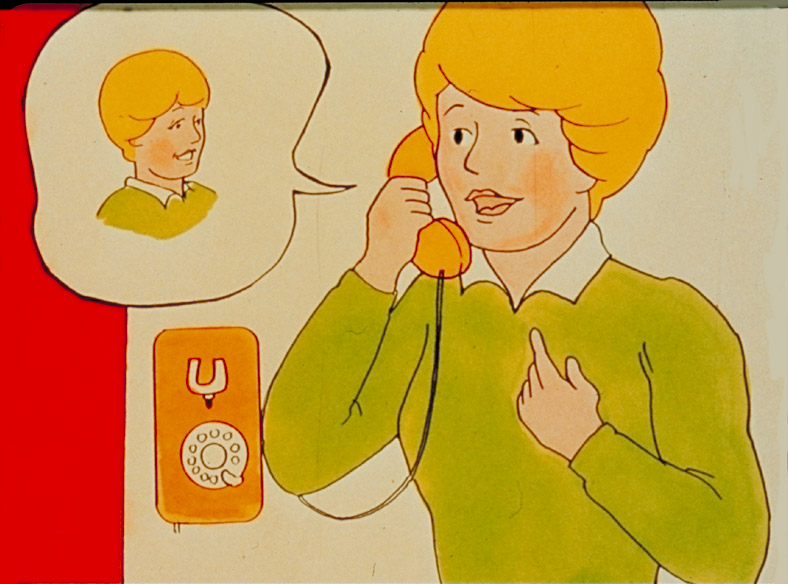 |
||||||||||||||||||||||||||||||||||||||||||||||||||||||||||||||||||||||||
This lesson focuses on telephone conversations and differing cultural contexts in Canada and Ukraine.
In Unit I, you were introduced to the adverbs ні (no) and так (yes). It is important to remember that these adverbs are always separated from other words in the sentence by a comma.
In this Unit, you were introduced to the preposition з (with) and its use with nouns in the Instrumental Case.
Review the use of з with the Instrumental Case as presented in Lesson 2. VII. Exercise 4.i Read the following sentences. Insert the name of your choice in the Instrumental Case.
Телефонні розмови Telephone conversations in Ukraine and Canada follow somewhat different patterns, largely due to the differing cultural and linguistic context. In Lesson 2 of this Unit, you were introduced to the first difference, which is the use of the word Алло / Альо in Ukraine and the word Галло in Canada. A few other interesting differences are noted below. Telephone conversations by Canadian speakers of Ukrainian often take on speech patterns which resemble their English phone conversations. The choice of vocabulary, tone and sentence structures reflect Canadian norms of telephone dialogue. Conversations will often feature such polite constructions as ‘Could you call Jim to the phone, please?’, ‘I was wondering if you could tell Tanya to call me back at…’ In Ukraine, people generally make such requests using the imperative form of verbs (the form which resembles a command). This is not considered rude or impertinent, but it is a culturally acceptable speech pattern. The imperative verb is often followed by the term будь ласка (if you would be so kind; please). In Canadian Ukrainian conversations, the word прошу (please) is used almost exclusively. In Ukraine, it is common to hear a sentence constructed as follows:
Cell phones are very popular among young people in both Ukraine and Canada. The Ukrainian word for cell phone is мобілка, from the term mobile phone. It is quite common for the younger generation of Ukrainians to have more than one mobile phone at their disposal! The following is an example of a short phone conversation in Ukraine. The name Liudmilla Borysivna reflects the use of the patronymic form of address (the father of Liudmilla is Borys) in Ukraine. Outside of Ukraine, the words пан, пані, панна (Mr., Mrs. Miss) are used as forms of address.
A typical short conversation in Canada is given below. With answering machines being quite common in Canada, people have come to rely on these machines or on other people to deliver messages about returning calls. In Ukraine, it is more common to thank the person who answers the call and then to call again later, without requesting that the message be passed along.
These comparisons do not signal 'right' or 'wrong' Ukrainian language use. They are offered as examples of typical phone conversations in their respective cultural settings. Числа ( Номери *) телефонів In Canada , phone numbers generally follow one pattern: 244 – 6658, with each digit identified individually. (Two –four – four; six – six – five – eight ). Even when the regional code is added, the numbers are given individually. Ukrainian phone numbers are grouped together in different ways, as follows:
It is not uncommon to hear other combinations, but the variations listed above are used most frequently. Native Ukrainian speakers may relate Canadian phone numbers using one of the patterns above, so you must know your Ukrainian number combinations well! Relating 'hundreds' in Ukrainian is not difficult. Note the following pattern:
Example: 653-7456 - six hundred fifty three, seventy four, fifty six :– шістсот п’ятдесят три, сімдесят чотири, п’ятдесят шість. We hope that you have enjoyed this look at some interesting cultural differences related to phone calls. Please remember that these are generalities, not strict rules!
VII. Exercise 4.i Part A. Write out the phone numbers below in words.
Part B. Write out the digits of the phone numbers given below.
Part C. Write out the digits of the phone numbers below, which are given in the native Ukrainian variant.
|
||||||||||||||||||||||||||||||||||||||||||||||||||||||||||||||||||||||||
|
||||||||||||||||||||||||||||||||||||||||||||||||||||||||||||||||||||||||



